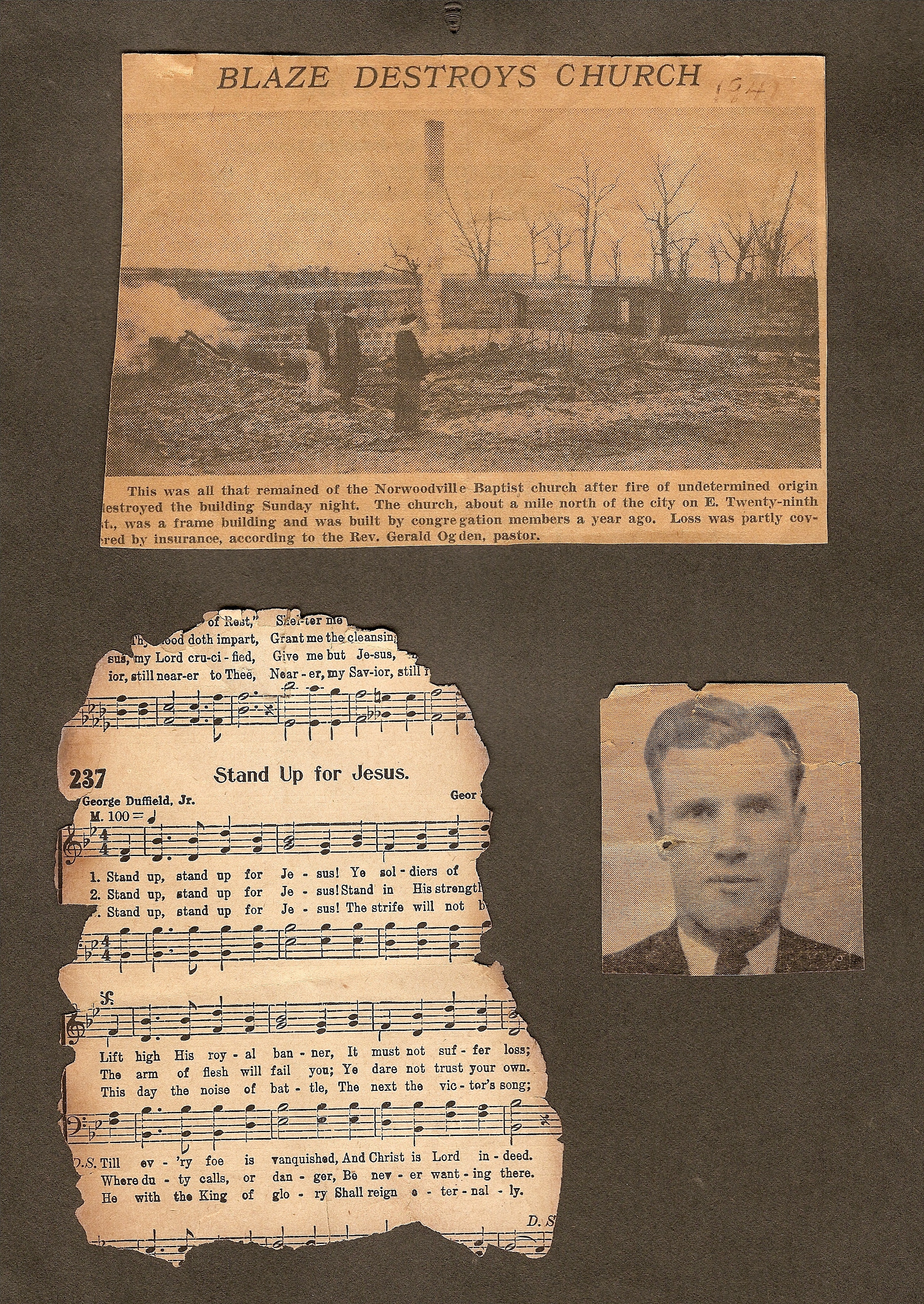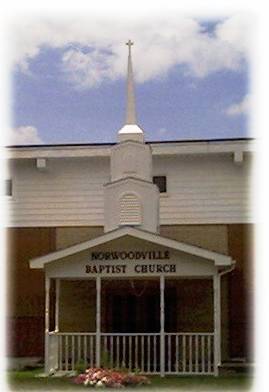|
|
Norwoodville Baptist Church
has a great heritage, and it would be impossible to recount all that God has done here. But we will try to give you
a snapshot view of this church's history. Praise God for what He has done in the past, and for what He will yet
do in the future! The following is an account of the early history of Norwoodville Baptist Church
by Gerald Zechariah Ogden, Norwoodville's first pastor. He pastored Norwoodville from August 1937 to the fall of
1943, then from September 1946 to July 1947. In the beginning, three fellows
saved at about the same time decided to do something to demonstrate our love for God. The three were Edd Lemke, Lonnie Pike,
and yours truly, Gerald Z. Ogden. All of us worked at Iowa Pack and were already buddies. Lonnie Pike said he knew of a lady who would rent a tent. Lonnie contacted the lady and came back with the information that the lady would sell the tent cheaper than she would rent it. To buy it would cost $15.00. The three of us contributed five dollars each and the tent was ours. The tent was erected on the northwest corner of Twenty-ninth and Broadway on the Norwoodville School grounds. Grandview Baptist Church, where Edd and I were members, loaned us seats, and services began with Edd leading the songs, Lonnie supplying the specials, and G. Z. bringing the messages. A young lady, Violet Dameron, from Grandview Baptist Church came each evening to play the piano. Many people were afraid to attend the revival. In spite of the threats against the services, they continued for five weeks. Souls were saved. I spent the nights inside the tent to guard it. One night after the service, I had a beautiful experience. There had been talk that the tent would be torn down that night. After the services when everyone had left except some fellows in cars out in front, I looked out of the tent. Here came nine young men around the tent. I opened the side curtain back up and said, "Why don’t you come on in and give your hearts to the Lord?" The boys said, "Preacher, we were sitting on the fence listening to you and that’s what we want to do." I said, "Come on in, and we’ll kneel down on this platform and you can give your hearts to God." "If we do," came the answer, "those fellows out in front would laugh at us.” "Yes, they would, wouldn’t they?" I replied. So I stepped over to the curtain and pulled it across the platform, and we knelt there. While I was showing them the plan of salvation, Brother Edd Lemke came back. He was thinking about me and thought I might need some help. Together we led these nine boys to the Lord, one of which later answered the call to preach the Gospel. Following this tent revival, we rented an empty house (with a store front) across the street cater-cornered from where the tent had been. Jenny Johnson attended and was the pianist. During those days, there was never a dull moment. Rocks were thrown at the building during our services, the church building was vandalized inside, the piano keys were painted, and many other happenings occurred. In order to have worship services, it was necessary to have police protection. This opposition came from an opposing religious organization. One night a fellow who had been drinking came to the meeting with the purpose of breaking up the service. He lit up his cigarette and when I asked him to put it out, he stuck it down in the coal bucket. I continued my sermon that I was preaching about hell. This fellow shouted back at me and created quite a disturbance. I told him that he would either have to be quiet or leave. He said, "You put me out." The officers were called in to escort the unruly visitor out. In the spring, Orville Hines and I went to northern Iowa and brought back a large tent since we no longer had the first tent. This tent was erected next to our meeting place and Evangelist O. E. Pierson conducted the revival. One night while this meeting was underway, a storm came up. Everyone had to leave the tent by either going into the building or into their cars. The tent was completely destroyed and that ended the revival. Then we learned that we could purchase the ground where the present church is located. There was an old house on the property which was dismantled and the 40’ x 60’ tabernacle was built. All the men worked and the women fixed lunches and helped, too. All the work was volunteer. The building was without any floor, without any ceiling, and without any windows. Instead of windows, we left openings that sometimes were covered with boards which could be opened up for ventilation when the weather permitted. A wood and coal furnace was placed under the platform. Now things were looking up! Brother Carver from Des Moines led the church in a successful revival. Brother Fred Meister engineered the start of installing the ceiling. But the opposition continued. There were a lot of threats that the church would be burned. One Sunday night following the service, after everyone had gone, we received the word that the church was on fire so we regathered. Since the building was covered with tar paper, there was a big fire. The next day as the women sorted through the ashes, all that could be found was a sheet from one of the hymnbooks. The hymn was "Stand Up For Jesus". We would not be defeated! Brother
and Sister Edd Lemke invited us to continue our services in the basement of their home while we rebuilt the church building
and this we did. This was probably about 1942. Material was hard to get and we had a shortage of money. Therefore, it was decided to start with a basement church and erect a sanctuary later. Brother Fred Meister contacted a crew of block layers to lay the basement walls. They donated their labor and the work was done on a Saturday. The men of the church followed with the roofing project. A platform was built, electricity was installed, and seats were obtained. We’re back in business! It’s Easter Sunday 1942! Our first service was held in the new basement. Approximately two hundred people were in attendance. Later we added ceiling tile and continued to lay the floor and work on the church. A new problem developed--a leaky roof, which turned out to be an intermittent continuous problem. The United States became involved in World War II. Being a true patriot and because many of the fellows I knew and many young men of the congregation were entering the service, I volunteered for the United States Navy where I remained until 1946 when I left the service and returned home. Feeling a desire to serve the Lord in evangelistic work, I decided to pursue my education. Therefore, I enrolled at Bible Baptist Seminary in Fort Worth, Texas, where J. Frank Norris was founder and president. From that time until the present, I have done and am doing the work of an evangelist besides doing interim pastorate work in churches that permit me freedom to also conduct revivals as the Lord leads.  |
